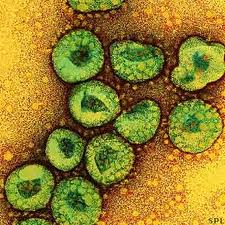A comprehensive paper was recently published online July 22, 2003 (Lancet 2003; 362: 263-70) regarding the causative microorganism of SARS.
Several investigators have collaborated in this study from viral laboratories of Rotterdam/The Netherlands, Hong Kong Special Administrative Region/China , Singapore, London/UK, Hamburg/Germany, Paris/France and Geneva/Switzerland.
This study involved isolation of the SARS-associated coronavirus (SARS-CoV) from SARS patients who died from the disease, propagation of the virus in an experimental animal model (cynomolgus macaques) and causing SARS again with an injection of the isolated virus back into a healthy experimental animal.
This, according to the authors (Dr. Thijs Kuiken et al.), fulfils the Koch’s postulates, which is one of the fundamental laws in microbiology that has to be fulfilled in order to claim a new infective organism. Dr. Robert Koch was a German physician who had detected the causative organisms of anthrax, tuberculosis and cholera and won the Nobel price for physiology and medicine in 1905. He developed the four original Koch’s postulates that were subsequently modified to a total of six. Here is a run down of the postulates and how it relates to SARS:
1. The specific organism should be present in all cases of animals suffering from a specific disease, but should not be found in healthy animals.
For SARS this was fulfilled as this study, which was based on a thorough analysis of 436 patients in six countries, showed. 75% of the suspected cases were found in postmortem studies to contain the SARS-associated coronavirus (SARS-CoV). In some patients other infectious agents could also be isolated, but the primary causative agent was SARS-CoV.
2. The specific organism should be isolated from a diseased animal and grown in pure culture on artificial laboratory media.
Using an experimental animal model, the virus was able to be isolated from a diseased person and injected into a healthy animal that turned sick with SARS. From this animal the virus could be isolated again from cells of the infected airways and grown in tissue culture.
3. This freshly isolated microorganism, when inoculated into a healthy laboratory animal, should cause the same disease as in the original animal.
As already explained under point 2 above, this has been shown with SARS.
4. The microorganism should be able to be isolated again in pure culture from the experimental infection.
This was proven in this paper regarding SARS. It was even done with genetic markers that were still present after passage from postmortem human tissue into an experimental animal and from the final respiratory tissue isolate of this newly infected animal.
5. The infective agent can be filtered and the filtrate contains the infective agent.
This was proven for SARS and the exact classification of the virus was possible because of the advanced genetic knowledge that is now available.
6. When the virus enters the body or the experimental animal, there are signs of the immune system attempting to rid the body of the infectious organism.
Sophisticated immune tests were performed that showed in more than one way that the immune system attempted to rid the body of SARS, but was eventually overwhelmed in the cases that did not survive.
Summary: This paper has conclusively proven that SARS is caused by a new type of coronavirus, SARS-associated coronavirus (SARS-CoV). In about 12% of cases there was another virus type present, such as human metapneumovirus. This occasionally was also present in lethal SARS cases as a secondary virus. Some other flu-type viruses were also found in the non-SARS cases. However, this paper has shown that SARS-associated coronavirus (SARS-CoV) is what causes SARS.
Link to SARS chapter of Dr. Schilling’s Net Health Book: http://nethealthbook.com/infectious-disease/infectious-disease-infections/severe-acute-respiratory-syndrome/
Last edited October 26, 2014






